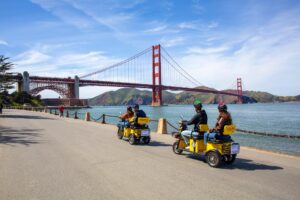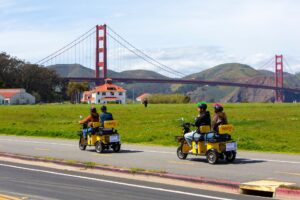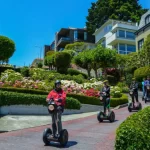5 fun facts about the Transamerica Pyramid
A Shapely Debate:
When plans for the Transamerica Pyramid were first revealed, many San Franciscans were not too thrilled about the idea of an obelisk-shaped skyscraper in their city. But now, it’s hard to imagine the city without the iconic pyramid shape, which has become a symbol of the city recognized worldwide.
A Tall Drink of Water:
At 853 feet, the Transamerica Pyramid is one of the tallest buildings in San Francisco. In fact, it’s so tall that if you stacked up all the cups of coffee San Franciscans drink in a year, it would reach the top of the pyramid (okay, maybe not, but it’s still pretty tall!)
A Clear View:
The Transamerica Pyramid has 3,678 windows, most of which pivot 360 degrees, allowing them to be cleaned from the inside of the building. This means that visitors can enjoy a crystal-clear view of the city from the top of the tower.
Power to the People:
In 2007, the Transamerica Pyramid installed a 1.1-megawatt combined heat and power system, making it one of only a handful of high-rise buildings in Northern California capable of generating their own electricity. Talk about being self-sufficient!
A Little Piece of Nature:
The Transamerica Pyramid Center also features Redwood Park, a half-acre redwood grove nestled between the skyscrapers of San Francisco’s Financial District. It’s a perfect spot for taking a break from the concrete jungle and enjoy a bit of nature in the middle of the city.
The Transamerica Pyramid: The Iconic Skyscraper That Defied Critics
When plans for the new Transamerica Corporation’s headquarters in downtown San Francisco were unveiled in 1968, there was public outcry. Many critics claimed that an obelisk-shaped skyscraper didn’t belong in their city. But today, it’s impossible to imagine the San Francisco skyline without the grace and symmetry of The Transamerica Pyramid at Transamerica Pyramid Center. A source of great pride to San Franciscans, The Transamerica Pyramid has become an icon of San Francisco recognized worldwide, along with the city’s famous cable cars and the Golden Gate Bridge.
The Transamerica Pyramid, with its unique pyramid shape, stands at 853 feet high and is one of the tallest buildings in San Francisco. The building is constructed of concrete, glass, and steel and is capped with a decorative aluminum 212-foot spire, which serves as the “crown jewel” of the building and a beacon at the top. The Transamerica Corporation began construction on the tower in 1969 and the first tenants moved in during the summer of 1972.
The Transamerica Pyramid boasts a total of 500,000 square feet of floor space and has 48 floors. The pyramid shape allows for varied floor plates, ranging from the 6th floor, with 22,226 square feet, to the 48th floor, with just 2,531 square feet. The building also has 3,678 windows, with most of them pivoting 360 degrees, which allows them to be cleaned from the inside of the building.
The tower’s foundation is 9-foot-deep concrete mat foundation, which was continuously poured over a 24-hour period with 1,750 truckloads of concrete. The foundation rests on a steel and concrete block, sunk 52 feet into the ground, and is designed to move with earth tremors. The Pyramid’s base and foundation is constructed of approximately 16,000 cubic yards of concrete, encasing more than 300 miles of steel reinforcing rods.
But the Transamerica Pyramid is not just a beautiful building, it also has an environmentally friendly side. In 2007, the Pyramid installed a 1.1-megawatt combined heat and power system, becoming one of only a handful of high-rise buildings in Northern California capable of generating their own electricity. Two 560 kW natural gas-fired reciprocating engine generators are designed to provide approximately 70 percent of the Pyramid’s electrical requirements and 100 percent of its heating and hot water.
The 48th floor of the building serves as an impressive conference room boasting stunning, unobstructed 360-degree views of San Francisco Bay. It’s a perfect spot for hosting events, meetings or just enjoying a bird’s eye view of the city.
But the Transamerica Pyramid Center is not just about the tower, it also has a unique feature, the privately owned Redwood Park.
Redwood Park at Transamerica Pyramid
A hidden gem located in the heart of San Francisco’s financial district. The park, which spans a half-acre, is a peaceful oasis surrounded by towering skyscrapers. The park’s main feature is the magnificent redwoods that were transplanted from the Santa Cruz Mountains, providing visitors with a glimpse of natural beauty amidst the hustle and bustle of the city.
Designed by Tom Galli, the park also includes a fountain designed by Anthony Guzzardo, complete with jumping frog sculptures, that serves as a tribute to Mark Twain, who once lived and wrote on this site. The soothing sound of running water adds to the tranquility of the park. Visitors can also enjoy a Glenna Goodacre bronze sculpture of children at play, a bronze plaque honoring two dogs that were said to be Emperor Norton’s canine sidekicks, and benches and tables for those looking to take a break.
Ferns, boulders, and a winding walkway add to the park’s natural beauty and make it the perfect spot for a lunch break or a peaceful stroll. The park is privately owned and open to the public, providing an opportunity for visitors to escape the concrete jungle and enjoy a bit of nature in the middle of the city. Whether you’re a local or just visiting, Redwood Park at Transamerica Pyramid is a must-see destination.
Transamerica Building FAQ:
Why was the Transamerica Pyramid built in the shape of a pyramid?
In addition to being a stylistic statement, the Transamerica Pyramid’s unconventional silhouette is also the result of environmentally sensitive planning. The tapered design casts a smaller shadow and therefore allows more natural light to filter down to the streets below than its conventional high-rise neighbors — important in a city where the sun has to do almost daily battle with the fog.
In designing the building, architects William Pereira & Associates also adhered to San Francisco’s unique shadow restriction legislation, which imposes a certain ratio between buildings’ surfaces and their heights.
What is the Crown Jewel?
The 6,000-watt beacon, envisioned by the architect as the building’s “crown jewel,” can be seen from all over the San Francisco Bay Area at night when lit on special occasions.
The aircraft light — a red flashing light at the top of the spire — is a 1,000-watt high-voltage neon lamp required by the FAA.
Can the windows of the Transamerica Pyramid be lit to create lighted shapes, like the Empire State Building in New York does?
No. All of the Pyramid’s interior lights are motion-activated for the purpose of energy conservation, and as a result, the building’s lights are only lit during business hours.
Can I visit the top of The Transamerica Pyramid for the view, or take a tour?
For security reasons, the Pyramid is not open to the public.
Is the Transamerica Pyramid designed to withstand earthquakes?
In a seismically active region, it is important to engineer buildings, especially skyscrapers, to withstand tremors. San Francisco is very close to the San Andreas and Hayward Faults — in fact, in 1989, the 6.9-magnitude Loma Prieta earthquake struck the Santa Cruz Mountains about 60 miles away. Although the 48-story-high Pyramid shook for more than a minute, during which the top story swayed almost a foot from side to side, the building was undamaged.
Such success can be attributed to the building’s careful structural engineering. In addition to its 52-foot-deep steel and concrete foundation, which is designed to move with earthquakes, the Transamerica Pyramid’s exterior is covered with white precast quartz aggregate, interlaced with reinforcing rods at four places on each floor. Clearance between the panels allows lateral movement in the event of an earthquake. In addition, a unique truss system above the first floor supports both vertical and horizontal loading, and interior frames extend up to the 45th floor.
As a result of all these measures, the building resists torsional movement and is engineered to take large horizontal base shear forces.
The Transamerica Pyramid is a registered trademark of Transamerica Corporation. Information provided by: Transamerica Pyramid Center







